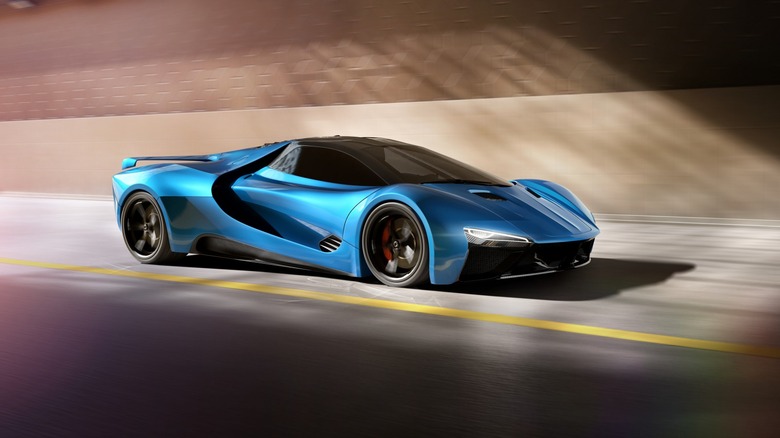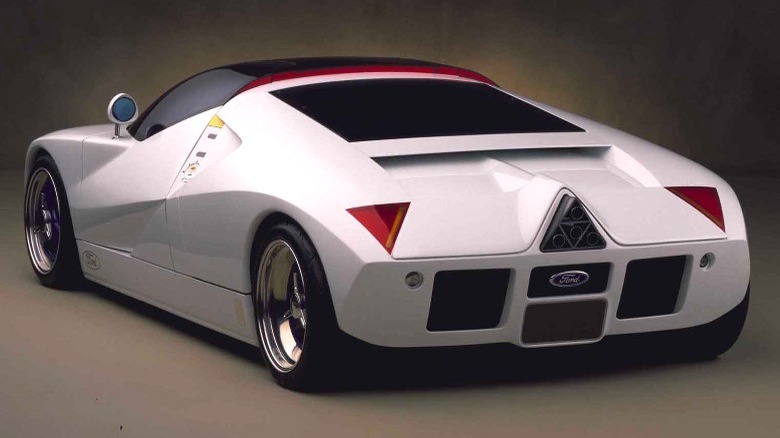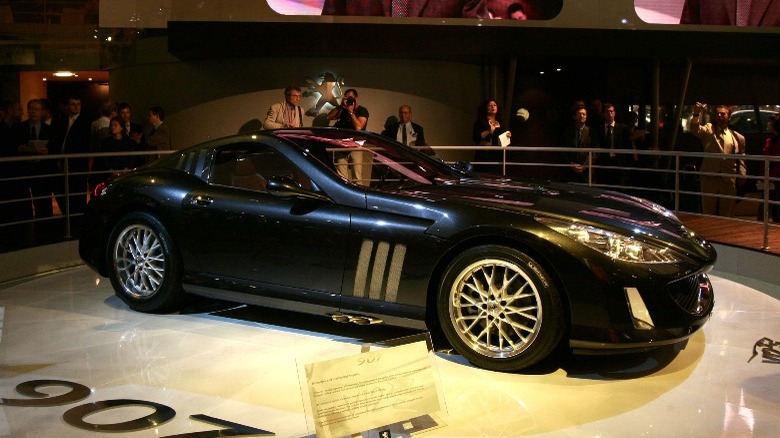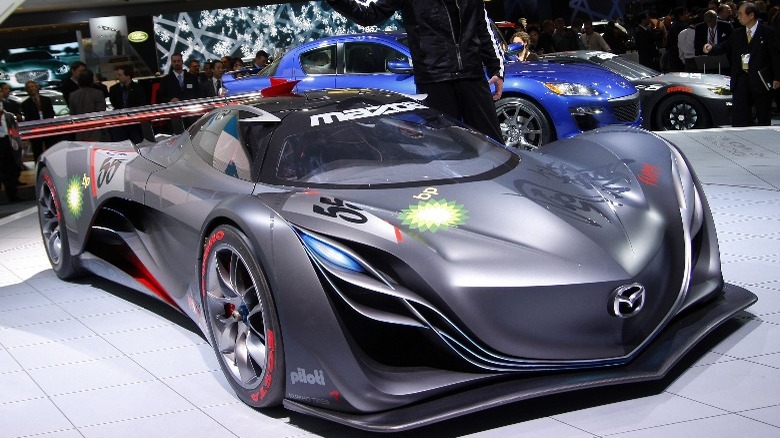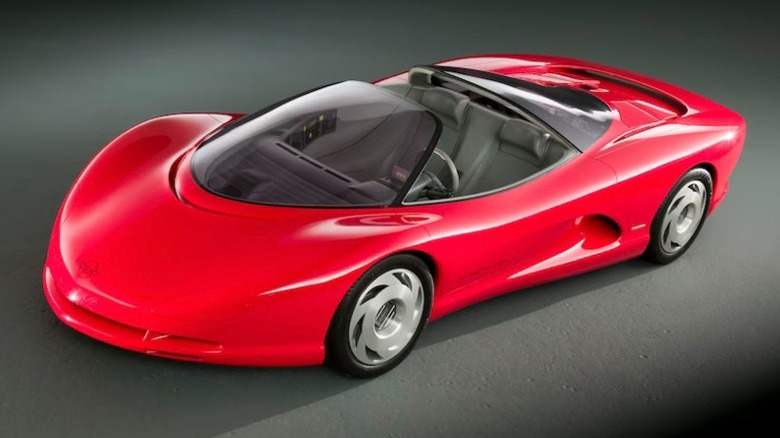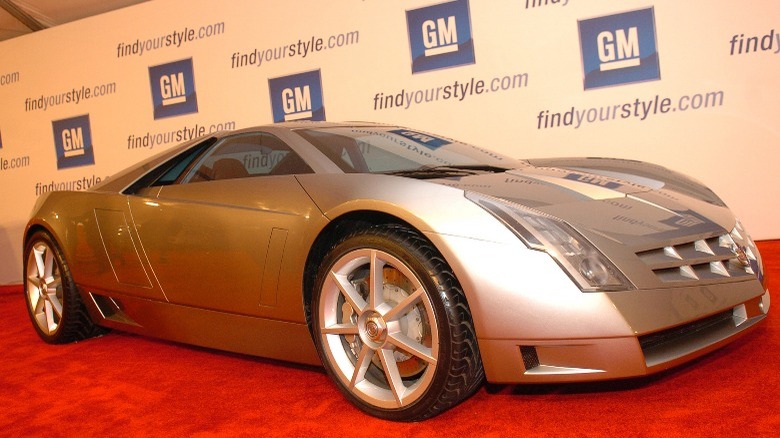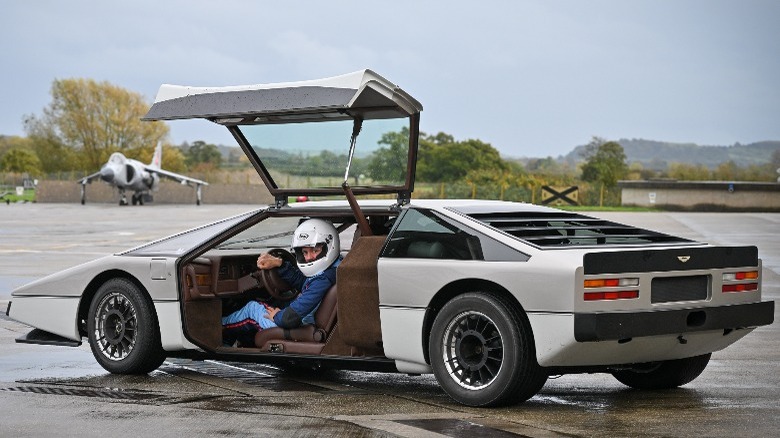The 6 Most Impressive Super Car Concepts That Were Never Actually Produced
The automotive world is full of different stylistic elements. From Lamborghini's iconic "Hexagon and the Y" to Mazda's KODO design language, each car manufacturer offers its products in recognizable packages for consistency in style and brand. Every once in a while, companies put all the limitations aside to showcase what the future of their automobiles could look like through a concept car.
As the name suggests, a concept car is a mere idea — a glimpse into the highest summits of a brand's imagination. Some concept models only dwell on a drawing board, while others might take the spotlight on an automobile exhibition with fully functioning powertrains and interior features.
Due to their mythical nature, concept cars always attract a lot of attention from car enthusiasts. Some concept models, such as the legendary Lexus LFA, reached the production line. However, most of these visionary examples never end up on the road. While the history of automobiles is not shy of wacky designs, some never-to-be concept supercars stand among the most impressive pieces of machinery in their own time.
Ford GT90
It's difficult to talk about concept supercars from the '90s and not bring the Ford GT90 into the conversation. Thirty years after beating Ferrari in the '66 Le Mans, Ford unveiled what the successor to the iconic GT40 could look like.
Ford used the Jaguar XJ220, one of the fastest cars of the early '90s, as a base to build the GT90. Debuted at the 1995 Detroit Motor Show, the GT90 took the spotlight with its heritage elements fused with a distinctly futuristic design. However, it wasn't just the looks that made the GT90 so special.
Under the hood, the GT90 features one of Ford's craziest engines ever built. Using its modular V8 powertrain as a blueprint, Ford added four more cylinders to create a 5.9-liter DOHC V12. What's more, Ford hooked up four Garret T2 turbochargers to force as much cool air as possible into the engine. The results? 720 horsepower and 660 lb-ft of torque. Even by today's standards, those numbers are impressive.
Peugeot 907
When it comes to supercar makers, no car enthusiast would put Peugeot at the top of their list. Besides its reputation in the rally scene, the French automaker is widely known for making affordable, family-oriented daily drivers. But by no means does this suggest Peugeot couldn't stand on the shoulders of giants if it wanted to.
Unveiled at the 2004 Paris Motor Show, the 907 was there to celebrate a new era in Peugeot's design. Before that, Peugeot was having a hard time competing with other rivals to stay in the market. Folks at Peugeot decided what they needed was a publicity stunt to bring the cool factor to the brand, and the 907 did exactly that.
With a long hood, aggressive angles all around, and a supercar silhouette, the 907 looks the part. But Peugeot knew looks alone wouldn't buy the brand much attention. Under the 907's long hood, Peugeot put two 3.0-liter V6 engines together to create a front-engined V12 supercar concept. Based on Peugeot's claims, the powertrain could put out 443 lb-ft of torque and deliver 500 horsepower to the wheels. Those numbers alone were impressive, and considering the car weighed just over 3,000 pounds, the power output made the 907 run from 0 to 60 mph in no more than four seconds.
Mazda Furai
One of the most underappreciated concept cars from Mazda, the Furai, debuted at the 2007 Tokyo Motor Show. In 2008, Mazda presented it outside of Japan for the first time at the North American International Autio Show in Detroit. Translated to "Sound of Wind," the Furai is Mazda's attempt at creating a race car concept for the road.
With all the aerodynamic curves, the Furai is a prime example of Mazda's unique Nagare (Japanese for "flow") design language. As futuristic as it looks, the Furai also pays tribute to Mazda's past achievements at the 1991 American Le Mans Series (ALMS). The "55" painted on the front of the car is inspired by Mazda's Le Mans-winning Courage C65. Moreover, the Furai shares the same chassis that Mazda used for the Courage C65.
Probably the most exciting part of the Furai for car enthusiasts is what's under the hood. Mazda is well-known for its iconic rotary engines found in cars like the JDM legend RX-7. For the Furai, Mazda built a there-rotor rotary powertrain that runs on ethanol (E100). According to Mazda, the engine puts out 450 horsepower.
Mazda had only made one example of the Furai. Unfortunately, it was destroyed by fire during Top Gear's track test later in 2008.
Chevrolet Corvette Indy
Unlike the legendary front-engined C2 Corvette, the powertrain in modern Corvettes sits behind the passenger seats. Although the transition was dramatic, folks at Chevy didn't wake up one day to send mid-engined Corvettes to the streets. Unveiled in 1986, the Corvette Indy concept car was Chevrolet's first attempt at creating a mid-engine layout for its iconic performance-oriented two-seater.
Inspired by cars from the Indianapolis Motor Speedway (Indy 500) auto race, the Corvette Indy came with a small block 2.7-liter twin-turbo V8 that could put out 600 horsepower. The engine wasn't the only exciting part of the Corvette Indy. This concept car came jam-packed with new technology that wasn't seen before on any Corvette.
Supplied by Lotus, the Corvette Indy featured active ride control and four-wheel steering. Moreover, the interior came with a long list of new features. A rearview camera, drive-by-wire steering, and satellite navigation system are only some of the techs the Corvette Indy offered in its cabin.
Chevy produced different versions of the Corvette Indy. Some models featured Lotus' DOHC 5.7-liter V8 that could reach 60 mph in six seconds flat. Later on, Chevy used the same engine for the 1990 Corvette ZR-1.
Cadillac Cien
In the early 2000s, Cadillac was struggling to find an audience among a younger generation of drivers. To boost its Image, Cadillac decided to work on a supercar concept to present for the company's 100th anniversary. In 2002, the result of a collaboration between Prodrive (a U.K.-based engineering company) and GM's Advanced Design Studio in England was unveiled at the Detroit Auto Show. Spanish for '100,' the Cien is Cadillac's fully functioning supercar concept.
With dramatic and angular lines, the Cien's design was inspired by the F-22 Raptor stealth fighter jet. Moreover, it featured Lamborghini-style scissor doors for an additional cool factor. Another design element inspired by Lamborghini supercars was active air vents that opened and closed mechanically. The active spoiler that moved up and down according to the vehicle's speed also helped the Cien look more futuristic.
Behind the passenger seats, the Cien housed a massive 7.5-liter V12 engine that could boast 750 horsepower and 450 lb-ft of torque. Based on Cadillac's claims, the Cien could sprint from idle to 60 mph in just 3.5 seconds and had a top speed of 217 mph.
Aston Martin Bulldog
Last but certainly not least, the Aston Martin Bulldog makes it to this list as one of the craziest supercar concepts that never had a production line, although the manufacturer had different plans at first. Initially, Aston Martin wanted to produce a limited number of supercars with the promise to surpass 200 mph in top speed.
In 1979, only one Bulldog rolled out of the Aston Martin factory. Unfortunately, due to financial issues, Aston Martin never managed to build other models. Allegedly, the 5.3-liter turbocharged V8 under the Bulldog's hood could produce 700 bhp and 500 lb-ft of torque.
Aston Martin claimed that the car had a top speed of 237 mph, which would've made it over 50 mph faster than any other road-legal of its time. Although 192 mph was the best Aston Martin could do with the Bulldog on the track, the British concept supercar was still faster than any of its rivals by several miles.
Forty years later, Richard Gauntlett and Classic Motor Cars (CMC) decided to restore the one-and-only Aston Martin Bulldog to its former glory in 2022. Goal? To reach the 200-mph mark that Aston Martin promised from day one.
